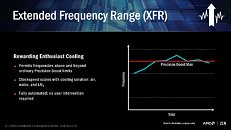Friday, February 10th 2017

AMD's "X" Nomenclature on Upcoming Ryzen Chips Related To XFR Feature
A Reddit user has used some good, old-fashioned thinking and inference (along with a good memory for details and investigative spirit) to try and shed some light on AMD's upcoming Ryzen chips - particularly, on the "X" part of their nomenclature.
As we've previously reported, upcoming AMD Ryzen chips will slot in two versions for each model: for example, there will be a R7 1700X, 8-core, 16-thread processor (with 95 W TDP), and expected to retail for $381.72, and a R7 1700 (sans "X"), also 8-core, 16-thread, with a rated TDP at 65 W, expected to retail at $316.59, almost $70 cheaper than the 1700X. Now, with AMD's promise of all Ryzen processors being multiplier unlocked (and thus user - or even through an automatic BIOS - overclockable), this would mean that acquiring the 1700X chip would somehow feel like bad business - after all, if the only difference between the two models were to be base and boost clocks (thus higher pricing and TDP), that would fall irrelevant to most power users, since the ability to overclock their Ryzen processors to those levels would be there anyway.Essentialy, AMD's "X" nomenclature regarding its upcoming Ryzen chips seems to denote the presence or absence of their touted XFR (eXtended Frequency Range) feature. This is part of AMD's SenseMI Technology suite, which aims to bring higher, intelligent performance to their Ryzen chips through the use of some particular technologies. XFR as it is, appears to be an added, automated overclocking capability to the chip, going further than the Precision Boost clocks would usually allow, supposedly scaling with the cooling performance of the end user's machine. This would fall in nicely with the rated TDP's of the non-X processors being rated at 65 W, with the X-branded, XFR-enabled processors featuring a higher theoretical TDP limit in-line with the capabilities of the XFR feature. As such, while it is true that an AMD Ryzen R7 1700 chip would also have base and boost clocks, much like their 1700X counterpart, the 1700's boost capabilities are designed for the chip not to surpass this 65 W hard limit. The 1700X, however, would be able to dynamically overclock according to the environment and cooling efficiency of the end user's rig, thus allowing it to, in some cases, hit a theoretical power consumption peak at the rated 95 W.
This theory (and AMD's strategy) would go some way to explain the high price difference between the 1700X and the 1700 R7 processors, which have a measly 100 MHz difference in their boost clocks favoring the 1700X (3.8 GHz vs 3.7 GHz on the 1700). After all, it still remains up in the air how good of an overclocker will AMD's ZEN architecture be, but a TDP difference of 30 W could go a long way overclocking-wise, especially when you consider AMD can apparently make these chips tick at 3.8 GHz with a measly 65 W TDP for an 8-core, 16-thread chip.
This strategy also makes sense in that power users who spend money on high-performance cooling solutions are probably more inclined to spend more on a CPU that promises (even if only theoretically) higher overclocking potential (we can expect these X chips to be cherry-picked samples with higher overclockability than other, non-X models). This also makes sense when one considers that the X versions of Ryzen chips are expected to ship with no cooling solution, whereas non-X models will ship with the company's "Wraith" cooling solution, more than enough for the non-power user who doesn't care about something like XFR. While it is a fact that most enthusiast users will simply buy the non-X chips and overclock them until the sky is no longer an achievement, it is also true that even some of us might feel more inclined towards simply "install and forget" high-performance, automatically-overclocked chips (also something the good Dr. Lisa Su mentioned during the "New Horizon" event, saying that XFR was "just for you enthusiast gamers").
Source:
Reddit user riuzaky2
As we've previously reported, upcoming AMD Ryzen chips will slot in two versions for each model: for example, there will be a R7 1700X, 8-core, 16-thread processor (with 95 W TDP), and expected to retail for $381.72, and a R7 1700 (sans "X"), also 8-core, 16-thread, with a rated TDP at 65 W, expected to retail at $316.59, almost $70 cheaper than the 1700X. Now, with AMD's promise of all Ryzen processors being multiplier unlocked (and thus user - or even through an automatic BIOS - overclockable), this would mean that acquiring the 1700X chip would somehow feel like bad business - after all, if the only difference between the two models were to be base and boost clocks (thus higher pricing and TDP), that would fall irrelevant to most power users, since the ability to overclock their Ryzen processors to those levels would be there anyway.Essentialy, AMD's "X" nomenclature regarding its upcoming Ryzen chips seems to denote the presence or absence of their touted XFR (eXtended Frequency Range) feature. This is part of AMD's SenseMI Technology suite, which aims to bring higher, intelligent performance to their Ryzen chips through the use of some particular technologies. XFR as it is, appears to be an added, automated overclocking capability to the chip, going further than the Precision Boost clocks would usually allow, supposedly scaling with the cooling performance of the end user's machine. This would fall in nicely with the rated TDP's of the non-X processors being rated at 65 W, with the X-branded, XFR-enabled processors featuring a higher theoretical TDP limit in-line with the capabilities of the XFR feature. As such, while it is true that an AMD Ryzen R7 1700 chip would also have base and boost clocks, much like their 1700X counterpart, the 1700's boost capabilities are designed for the chip not to surpass this 65 W hard limit. The 1700X, however, would be able to dynamically overclock according to the environment and cooling efficiency of the end user's rig, thus allowing it to, in some cases, hit a theoretical power consumption peak at the rated 95 W.
This theory (and AMD's strategy) would go some way to explain the high price difference between the 1700X and the 1700 R7 processors, which have a measly 100 MHz difference in their boost clocks favoring the 1700X (3.8 GHz vs 3.7 GHz on the 1700). After all, it still remains up in the air how good of an overclocker will AMD's ZEN architecture be, but a TDP difference of 30 W could go a long way overclocking-wise, especially when you consider AMD can apparently make these chips tick at 3.8 GHz with a measly 65 W TDP for an 8-core, 16-thread chip.
This strategy also makes sense in that power users who spend money on high-performance cooling solutions are probably more inclined to spend more on a CPU that promises (even if only theoretically) higher overclocking potential (we can expect these X chips to be cherry-picked samples with higher overclockability than other, non-X models). This also makes sense when one considers that the X versions of Ryzen chips are expected to ship with no cooling solution, whereas non-X models will ship with the company's "Wraith" cooling solution, more than enough for the non-power user who doesn't care about something like XFR. While it is a fact that most enthusiast users will simply buy the non-X chips and overclock them until the sky is no longer an achievement, it is also true that even some of us might feel more inclined towards simply "install and forget" high-performance, automatically-overclocked chips (also something the good Dr. Lisa Su mentioned during the "New Horizon" event, saying that XFR was "just for you enthusiast gamers").




71 Comments on AMD's "X" Nomenclature on Upcoming Ryzen Chips Related To XFR Feature
Its a cool feature already, so having it on processors would definitely be a plus especially to those who are not big on overclocking themselves. Sounds like its just part of the binning process so the lower chips will just need more voltage and not be able to do this which is fine for the most part anyways as I am sure the difference is probably going to be (Max OC to Max OC) within 500mhz.
All in great plan imho.
Intel will launch a 10GHz CPU at some time in the future.
YOU READ IT ON TPU FIRST.
They are both doing this to a degree in not fully clear on Nvidias methods but a chip has its limits but these days we can have a card that's not going to get to reach them since tdp temp load and power draw decide what clocks are running , Aes instructions for example strain CPUs hard and give more heat for a given clock then integer, running an fx has definitely made me aware that different loads Result in tragic looking temps on it ,5ghz easy gaming50℅ 4.4-4.6 66℅ folding.
So for me it Is needed no a necessity.
It's the same as 8350 and it's "e" version or Intel's k to non k , what dya think the multiplier setting is really broken on non k and it couldn't have worked.
It isn't the same as the "e" version or Intel's K vs non-k processors at all.
I don't think Wizz liked it and nor did I get the job. :p
videocardz.com/65825/first-amd-ryzen-7-1700x-benchmarks-are-here
Our platform is 3 years old, that mean AMD is arround 2 years behind Intel.
From other side even 2014 I knew that investing in 4 core CPU is mistake, between small number of cores and good frequency and bigger number of core and small frequency my conlclusion was that 6 cores on 4.2-4.4GHz are better for investment. Customers had a great options only they didn't look better, I paid mine i7-5820K 280 euro exactly 6 months after launch.
But people who paid almost 400$ for i7-6700K/I7-7700K and now AMD is much stronger.... Price of i7 K should be 200$ long time ago. We have performance improvement from Sandy Bridge to Kaby Lake not much higher than 30%. Between them are few models with 5% improvements... Only idiot is not capable to destroy that with single generation if work long time on platform.
I WILL STAY LOYAL TO INTEL, THEY SERVE ME WELL MORE THAN 6-7 YEARS, AND WITH THEM I'M SECURE, ALWAYS GOOD PERFORMANCE, WITH AMD ARE ALWAYS SOME EXPECTATIONS AND YOU NEED TO LOOK BETWEEN LINES WHAT HAPPEN...
But upgrade from i7-5820K to i7-6900K would be great. AMD can't beat i7-6900K on same frequency... example 4.2GHz... No way.:)
On their own demo Intel's 145W rated chip consumed less than 10 watts more than their own 95W rated chip.
What's the deal with all those "95w" 8 cores and "65W" 6 cores? What's the point???
So AMD is not saying the chips use less power (which as you point out is technically true), they are saying they run cooler or will take less to keep cool.
All GPUs are volt limited all CPUs have limits too because as I said loads these days are very dynamic some give massive heat.
Due to the way shit works tdp can be an indicator of switching efficiency in chips and or rated leakage.
But it isn't the same anymore and it isn't just for AMD Intel made up Sdp to replace Tdp since by their reckoning a down clocked core might get within the reach of Arms efficiency and OEMs want that as do EU law.Yeah definitely but the 95watts was not meant as power directly and only indirectly is now